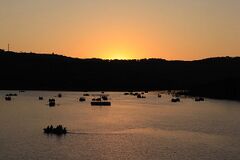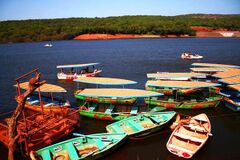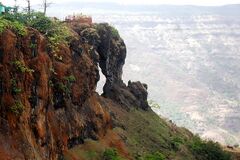Mahabaleshwar
Mahabaleshwar | |
|---|---|
Mahabaleshwar is located in Maharashtra Mahabaleshwar | |
| Coordinates: 17°55′30″N 73°39′27″E / 17.9250°N 73.6575°E | |
| Country | File:Flag of India.svg India |
| State | Maharashtra |
| District | Satara District |
| Area | |
• Total | 137.15 km2 (52.95 sq mi) |
| Elevation | 1,353 m (4,439 ft) |
| Population (2011) | |
• Total | 12,737 |
| • Density | 93/km2 (240/sq mi) |
| Languages | |
| • Official | Marathi |
| Time zone | UTC+5:30 (IST) |
| Sex ratio | 90 females/ 100 males ♀/♂ |
| Literacy Rate | 78% |
Mahabaleshwar () is a small town and a municipal council in Satara district, Maharashtra, India. It is a place of pilgrimage for Hindus because the Krishna River has its origin here.[1] The British colonial rulers developed the town as a hill station, and it served as the summer capital of the Bombay Presidency during the British Raj.
Geography
Mahabaleshwar is located on the mountainous Sahyadri range of the Western Ghats that run North to south along the western coast of India. The coordinates of the town are 17°55′30″N 73°39′27″E / 17.9250°N 73.6575°E.[2] Mahabaleshwar is a vast plateau measuring 150 km2 (58 sq mi), bound by valleys on all sides. It reaches a height of 1,439 m (4,721 ft) at its highest peak above sea level, known as Wilson/Sunrise Point. The town is about 122 km (76 mi) southwest of Pune and 285 km (177 mi) from Mumbai. Mahabaleshwar comprises three villages: Malcolm Peth, Old "Kshetra" Mahabaleshwar, and part of the Shindola village. The Mahabaleshwar region is the source of the Krishna River that flows east across Maharashtra, Karnataka, Telangana, and Andhra Pradesh towards the Bay of Bengal. Three tributaries of Krishna, namely Koyna, Venna (Veni) and Gayatri, also have their source in Mahabaleshwar region. A fourth river, the Savitri, also has its source in the region, but flows Westward via Mahad to the Arabian Sea.[3][4] The area's climate is suitable for cultivation of strawberries; Mahabaleshwar strawberry contributes to about 85 percent of the total strawberry production in the country.[5][6][7][8] It also received the geographical indication (GI) tag in 2010.[9]
Climate
Mahabaleshwar has a borderline tropical monsoon/humid subtropical climate (Köppen Am/Cwa). Very heavy rainfall is a normal occurrence during monsoons. During July, 10–12 days of continuous rains with 100 to 200 mm or 4 to 8 in each day occur each year. There were reports of ice and ground frost formation around Venna Lake in 2018.[10][11] On August 7, 2019, Mahabaleshwar recorded 330 mm or 12.99 in of rain in 24 hours causing landslides.[12] Mahabaleshwar has been described as the "New Candidate for the wettest place in the world", the title currently held by Cherrapunji.[13]
| Climate data for Mahabaleshwar (1991–2020, extremes 1932–2011). Mahabaleshwar's summers are colder than spring, fall and winter.|- | Month | Jan | Feb | Mar | Apr | May | Jun | Jul | Aug | Sep | Oct | Nov | Dec | Year | |||||||||||||
|---|---|---|---|---|---|---|---|---|---|---|---|---|---|---|---|---|---|---|---|---|---|---|---|---|---|---|---|
| Record high °C (°F) | 32.4 (90.3) |
33.9 (93.0) |
38.2 (100.8) |
37.6 (99.7) |
37.4 (99.3) |
34.8 (94.6) |
31.7 (89.1) |
29.6 (85.3) |
29.2 (84.6) |
31.9 (89.4) |
30.8 (87.4) |
31.0 (87.8) |
38.2 (100.8) | ||||||||||||||
| Mean daily maximum °C (°F) | 26.4 (79.5) |
28.1 (82.6) |
31.0 (87.8) |
32.1 (89.8) |
30.5 (86.9) |
23.8 (74.8) |
20.1 (68.2) |
19.7 (67.5) |
21.8 (71.2) |
25.8 (78.4) |
25.9 (78.6) |
26.1 (79.0) |
26.0 (78.8) | ||||||||||||||
| Mean daily minimum °C (°F) | 13.4 (56.1) |
14.7 (58.5) |
17.3 (63.1) |
18.9 (66.0) |
18.4 (65.1) |
17.6 (63.7) |
17.1 (62.8) |
16.8 (62.2) |
16.3 (61.3) |
16.3 (61.3) |
15.2 (59.4) |
13.9 (57.0) |
16.3 (61.3) | ||||||||||||||
| Record low °C (°F) | 0.0 (32.0) |
3.9 (39.0) |
7.7 (45.9) |
11.1 (52.0) |
12.5 (54.5) |
12.0 (53.6) |
12.2 (54.0) |
11.3 (52.3) |
10.5 (50.9) |
10.0 (50.0) |
7.4 (45.3) |
6.4 (43.5) |
0.0 (32.0) | ||||||||||||||
| Average rainfall mm (inches) | 1.0 (0.04) |
0.5 (0.02) |
6.1 (0.24) |
20.1 (0.79) |
46.1 (1.81) |
958.4 (37.73) |
2,197.4 (86.51) |
1,806.9 (71.14) |
657.4 (25.88) |
157.6 (6.20) |
25.1 (0.99) |
5.9 (0.23) |
5,882.6 (231.60) | ||||||||||||||
| Average rainy days | 0.1 | 0.1 | 0.5 | 1.4 | 3.4 | 19.9 | 29.7 | 29.1 | 19.1 | 8.0 | 2.0 | 0.4 | 113.8 | ||||||||||||||
| Average relative humidity (%) (at 17:30 IST) | 49 | 39 | 41 | 51 | 67 | 92 | 98 | 98 | 94 | 76 | 64 | 56 | 69 | ||||||||||||||
| Source 1: India Meteorological Department[14][15] | |||||||||||||||||||||||||||
| Source 2: Government of Maharashtra[16] | |||||||||||||||||||||||||||
History
Legend says that a Yadava ruler from 13th century built a small temple and water tank at the source of the river Krishna.[17] The Valley of Jawali, the area around Mahabaleshwar, was ruled by the More (clan) who were vassals of the Adilshahi sultanate of Bijapur. In 1656, the founder of Maratha empire, Chhatrapati Shivaji, killed the then ruler of Valley of Javali, Chandrarao More, and seized the area.[18][19] Around that time Shivaji also built a hill fort near Mahabaleshwar called Pratapgad fort.[20][21]
British colonial era

In 1819, after the demise of the Maratha empire, the British ceded the hills around Mahabaleshwar to the vassal state of Satara. Colonel Lodwick (Later General Sir Lodwick) after climbing the mountains near Mahabaleshwar, recommended the place as a sanatorium for the British forces to governor Sir John Malcolm of Bombay presidency. The Raja of Satara was granted other villages in exchange for the British getting Mahabaleshwar in 1828.[22] In old records Mahabaleshwar was even called Malcolm Peth after the governor.[23] Mahabaleshwar started gaining prominence when British officials of the Bombay presidency such as Sir Mountstuart Elphinstone, Arthur Malet (for whom the seat at "Point Arthur" is named), Carnac, and many others became regular visitors. Venna Lake was constructed in 1842 to collect water from perennial springs; the Venna River flows from this lake.[24] Bartley Frere, the commissioner of Satara in the 1850s, built the road from Satara to Mahabaleshwar.[25] In the mid 1800s, Mahabaleshwar was made into the summer capital of the Bombay presidency.[26] Government spending led to rapid development of the area. Colonial officials spent part of their year in the area. Their wives spent a longer period of the year in the area to be with their children in local boarding schools in Mahabaleshwar and nearby Panchgani.[27][28] The British rulers wanted to recreate the English landscape in the hill stations and to that end, European flora such as strawberries[29] were introduced in Mahabaleshwar, and amenities such as libraries, theatres, boating lakes, and sports grounds were constructed.[30] Added to the scores of magnificent scenic "points", the perennial springs, streams, and waterfalls of Mahabaleshwar plateau, with its year round superb climate, drew the English and others to Mahabaleshwar. By the end of the 19th century it had become an attractive popular hill station of world renown. Raj Bhavan, the summer residence of the Governor of Maharashtra, is also located here. An older building named "The Terraces" was purchased in 1884 and rechristened as Giri Darshan in 1886.[31] "Babington House", is a colonial-style bungalow built in the shape of a cross with a deep veranda, elaborate metal work railing and extensive outhouses. It was formerly one of the country seats of the Dubash family, a Parsi ship chandler dynasty from Bombay, before they sold it to the Rahejas in the early 1970s. It contains a central dining room with a 24-seater table and a library pavilion with 1st edition books collected by the Dubash family, notably Jamsetjee "Jimmy" Kavasjee Dubash, a bibliophile and art collector.[citation needed]
Demographics
As of 2011[update] India census,[32] Mahabaleshwar had a population of 12,737. Males constituted 55% of the population and females 45%. Mahabaleshwar had an average literacy rate of 78%, higher than the national average of 74.04%: male literacy was 84%, and female literacy was 71%. In Mahabaleshwar, 11% of the population was at that time under 6 years of age. 90% of population speaks Marathi language.
Transport
Rail
Nearest railway station to Mahabaleshwar is Satara, 60 km. Nearby major railway stations include Pune (120 km), Sangli railway station (170 km). State-run bus services are available in these locations to Mahabaleshwar. Rail station Diwan Khavati on Kokan Railway near Khed gives a route of 60 km via Poladpur to Mahabaleshwar.
Air
The nearest airport is Pune International Airport, serving the city of Pune, 120 km from Mahabaleshwar. Chhatrapati Shivaji Maharaj International Airport of Mumbai is 270 km.
Tourism
Pratapgad
A popular place to visit is the historic fort of Pratapgad built by Chatrapati Shivaji. It is the site of the encounter between Shivaji Maharaj and Bijapur general, Afzal Khan, where the latter was defeated and killed by Chhatrapati Shivaji Maharaj.[33] There are small shops, restaurants and a handicrafts store. Many schools also arrange educational trips to the fort. The fort is also on many trekking routes of the area.[34]
Gallery of places of interest to tourism
-
Panoramic view from Savitri Point, Mahabaleshwar
-
A view from Arthur seat point
-
The Venna lake
-
Boats on the Venna lake in Mahabaleshwar.
-
Balakwadi dam viewed from Kate's Point
-
Needle hole rock, viewed from the point
-
Panoramic view of Lingamala waterfalls
In popular culture
| File:Information icon4.svg |
Movies filmed in Mahabaleshwar include Raj Kapoor's Barsaat (1949),[35]Hrishikesh Mukherjee's Anupama (1966)[36][37] and Basu Chatterji's Chitchor (1976).[38] In December 2020, some scenes of RRR (2022) were filmed around Mahabaleshwar, notably scenes involving Alia Bhatt.[39] Some scenes of the Kannada film Vikrant Rona (2022), starring Sudeepa, were filmed around the hill station. Other hill stations such as Panchgani and Wai are also popular filming locations. For example, in 2021 Kartik Aaryan filmed the movie Freddy (2022) in Panchgani.[40]
References
- ↑ Talbot, Ian (2016). A History of Modern South Asia: Politics, States, Diasporas. Yale University Press. p. 36. ISBN 978-0-300-19694-8. Archived from the original on 2 June 2022. Retrieved 17 April 2020.
- ↑ "Falling Rain Genomics, Mahabaleshwar". Archived from the original on 3 May 2006. Retrieved 29 November 2007.
- ↑ Balasubramanian, Lalitha (30 August 2017). Temples in Maharashtra: A Travel Guide. Notion Press. ISBN 978-1-947697-88-1.
- ↑ Puri, G. S., & Mahajan, S. D. (1960). The study of the evergreen vegetation of Mahabaleshwar area. Nelumbo, 2(1-2), 109-137.[1]
- ↑ Kasabe, Nanda (18 February 2012). "Growing demand for strawberries in domestic market". The Financial Express. Archived from the original on 30 January 2018. Retrieved 1 February 2016.
- ↑ Kshirsagar, Alka (16 January 2012). "Mahabaleshwar set for good strawberry season". The Hindu Business Line. Retrieved 27 January 2016.
- ↑ Mahableshwar-where strawberries grow:https://www.outlookindia.com/newsscroll/mahabaleshwar--where-strawberries-grow/1757666 Archived 18 July 2020 at the Wayback Machine
- ↑ Strawberry fields forever:https://punemirror.indiatimes.com/entertainment/unwind/strawberry-fields-forever/articleshow/74419558.cms Archived 18 July 2020 at the Wayback Machine
- ↑ Joshi, Hrishikesh (14 May 2010). "Mahabaleshwar strawberry gets GI status". Business Standard. Archived from the original on 3 April 2016. Retrieved 27 January 2016.
- ↑ "Cold wave grips parts of India: Delhi continues to freeze; Nagpur gets colder than Shimla; Pune records coldest morning in 18 years". Firstpost. 30 December 2018. Archived from the original on 20 April 2021. Retrieved 20 April 2021.
- ↑ "In-pics: Maharashtra's Mahabaleshwar witnesses frozen dew drops". Hindustan Times. 8 January 2017. Archived from the original on 20 April 2021. Retrieved 20 April 2021.
- ↑ Dighe, Sandip; Joshi, Satyajit (7 August 2019). "Stay off roads to Mahabaleshwar, heavy rain floods Satara, Sangli districts too". The Times of India. Archived from the original on 20 April 2021. Retrieved 20 April 2021.
- ↑ "Mahabaleshwar: New Candidate for Wettest Place on Earth". The Weather Channel. Archived from the original on 26 April 2021. Retrieved 26 April 2021.
- ↑ "Station: Mahabaleshwar Climatological Table 1981–2010". Climatological Normals 1981–2010. India Meteorological Department. January 2015. pp. 457–458. Archived from the original on 5 February 2020. Retrieved 9 April 2020.
- ↑ "Extremes of Temperature & Rainfall for Indian Stations (Up to 2012)" (PDF). India Meteorological Department. December 2016. p. M145. Archived from the original (PDF) on 5 February 2020. Retrieved 9 April 2020.
- ↑ "Climate". Government of Maharashtra. Archived from the original on 14 March 2016. Retrieved 9 April 2020.
- ↑ Gundawar, P., Sinha, D.K. and Wable, P., 2008. A critical investigation of motivating factors responsible for increase in pleasure tourism at Panchgani and Mahabaleshwar,Conference on Tourism in India – Challenges Ahead, 15–17 May 2008, IIMK [2] Archived 20 April 2021 at the Wayback Machine
- ↑ Farooqui, Salma Ahmed (2011). A Comprehensive History of Medieval India: Twelfth to the Mid-Eighteenth Century. Pearson Education India. p. 317. ISBN 978-81-317-3202-1.
- ↑ Chakrabarty, Dipesh (2015). The Calling of History: Sir Jadunath Sarkar and His Empire of Truth. University of Chicago Press. p. 147. ISBN 978-0-226-24024-4. Archived from the original on 19 July 2021. Retrieved 23 April 2021.
- ↑ Gordon, Stewart (1 February 2007). The Marathas 1600-1818. Cambridge University Press. pp. 62–. ISBN 978-0-521-03316-9. Archived from the original on 16 April 2022. Retrieved 21 March 2022.
- ↑ Puri, G.S. and Mahajan, S.D., 1960. The study of the evergreen vegetation of Mahabaleshwar area. Nelumbo-The Bulletin of the Botanical Survey of India, 2(1-2), pp.109-137.[3] Archived 2 June 2022 at the Wayback Machine
- ↑ Kulkarni, Sumitra (1995). The Satara Raj, 1818-1848: A Study in History, Administration, and Culture. Mittal Publications. pp. 174–177. ISBN 978-81-7099-581-4. Archived from the original on 21 July 2020. Retrieved 23 April 2021.
- ↑ Dane Keith Kennedy (1 January 1996). The Magic Mountains: Hill Stations and the British Raj. University of California Press. p. 24. ISBN 978-0-520-20188-0. Archived from the original on 31 December 2021. Retrieved 23 April 2021.
- ↑ Puri, G.S. and Mahajan, S.D., 1960. The study of the evergreen vegetation of Mahabaleshwar area. Nelumbo, 2(1-2), pp.109-137.[4] Archived 13 November 2020 at the Wayback Machine
- ↑ Ranade, Rekha (1990). Sir Bartle Frere and His Times: A Study of His Bombay Years, 1862-1867. Mittal Publications. pp. 9–. ISBN 978-81-7099-222-6. Archived from the original on 2 June 2022. Retrieved 23 April 2021.
- ↑ Knight, Lionel (2012). Britain in India, 1858-1947. Anthem Press. p. 15. ISBN 978-0-85728-517-1. Archived from the original on 11 June 2020. Retrieved 9 June 2020.
- ↑ Baker, K., 2009. The changing tourist gaze in India’s hill stations: from the early nineteenth century to the present. Environment, Politics and Development Working Paper Series. London: Department of Geography, King’s College. Available online: http://www Archived 2 February 2008 at the Wayback Machine. kcl. ac. uk/schools/sspp/geography/research/epd/working. html.[5]
- ↑ Burns, Peter M.; Palmer, Cathy; Jo-Anne Lester; Baker, Kathleen (2010). Tourism and Visual Culture Theories and concepts. CABI. pp. 2, 5, 11. ISBN 978-1-84593-609-9. Archived from the original on 2 June 2022. Retrieved 23 April 2021.
- ↑ "Mahabaleshwar strawberry gets GI status". Archived from the original on 11 January 2020. Retrieved 16 April 2020.
- ↑ Dossal, Mariam; Maloni, Ruby (1999). State Intervention and Popular Response: Western India in the Nineteenth Century. Popular Prakashan. pp. 32–34. ISBN 978-81-7154-855-2. Archived from the original on 2 June 2022. Retrieved 23 April 2021.
- ↑ "The History of Raj Bhavan, Mumbai". Archived from the original on 25 March 2016. Retrieved 8 February 2016.
- ↑ "Census of India 2001: Data from the 2001 Census, including cities, villages and towns (Provisional)". Census Commission of India. Archived from the original on 16 June 2004. Retrieved 1 November 2008.
- ↑ Gunaji, Milind (2010). Offbeat tracks in Maharashtra (2nd ed.). Mumbai: Popular Prakashan. pp. 43–44. ISBN 9788179915783.
- ↑ Kapadia, Harish (2003). Trek the Sahyadris (5. ed.). New Delhi: Indus Publ. pp. 144–146. ISBN 9788173871511.
- ↑ Nanda, R. and Kapūra, R., 2002. Raj Kapoor Speaks. Penguin Books India.
- ↑ Singh, J.A., 2016. The World of Hrishikesh Mukherjee. Penguin UK.
- ↑ The Sound of Silence Indian Express, March 15, 2015.
- ↑ Arya, K.K. and Verma, M., A Navarasa-based Analysis of Love (Sringa-ra) in Middle Cinema’s Chitchor versus Do-mestic Drama’s Main Prem Ki Diwani Hoon.ISSN 2319-5339 IIS Univ.J.A. Vol.10 (2), 310–27 (2021)
- ↑ "Alia Bhatt Finally Joins 'RRR' Cast for Shoot in Mahabaleshwar". News 18.
- ↑ "Kartik Aaryan..." Hindustan Times.
External links
- Mahabaleshwar page of Maharashtra Tourism website
- File:Commons-logo.svg Media related to Mahabaleshwar at Wikimedia Commons





